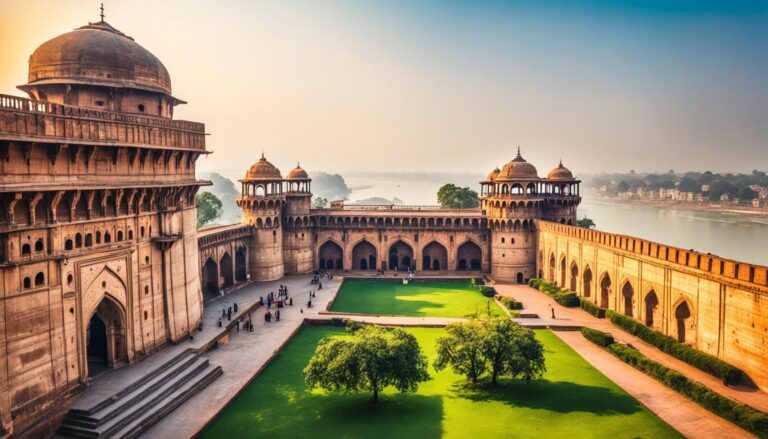|
Listen to this article now
Getting your Trinity Audio player ready...
|
Standing majestically along the confluence of the Ganga and Yamuna rivers in Prayagraj, the Allahabad Fort is a silent witness to centuries of India’s vibrant history. Built by Emperor Akbar in 1583, this fort blends Mughal architecture with strategic brilliance. Yet, beyond its imposing walls lies a tapestry of untold stories—of emperors, pilgrims, warriors, and spiritual legends.
In this blog, we uncover the hidden layers of Allahabad Fort’s glorious past and why it continues to capture the imagination of historians and travelers alike.
The Mughal Era: Akbar’s Vision
When Akbar commissioned Allahabad Fort, his aim was clear: consolidate Mughal power in eastern India and protect the sacred Triveni Sangam. Prayagraj (then called Prayag) was already revered as a spiritual epicenter, and Akbar’s fort added a political and military dimension to its sanctity.
🔹 Built In: 1583
🔹 Purpose: Military fortification and administrative center
🔹 Unique Features: Gigantic walls, lofty towers, and grand gates designed in Mughal-Persian style
Interestingly, the fort houses the ancient Ashoka Pillar, carrying inscriptions from the 3rd century BCE and later Mughal records, making it a living document of Indian history.

The Fort’s Spiritual Significance
Unlike typical Mughal forts, Allahabad Fort incorporated sacred Hindu elements:
-
Akshayavat Tree: The immortal banyan tree located inside the fort, believed to grant salvation to those who died under it.
-
Patalpuri Temple: An ancient underground temple said to house countless spirits and deities.
- location : Minto Park, Allahabad 211002 India
Thus, the fort was not just a military stronghold but a symbol of the syncretism between Mughal rule and Hindu spirituality.
The Colonial Chapter: British Domination
As the Mughal empire declined, Allahabad Fort changed hands. In 1765, the British East India Company took control after the Treaty of Allahabad, turning the fort into a vital military garrison.
🔹 Key Moments:
-
Played a crucial role during the Revolt of 1857
-
Used to suppress nationalist movements
-
Partially converted into British administrative offices
The fort remained a stronghold of colonial power until India’s independence in 1947.
Architecture: A Blend of Power and Grace
The fort’s architecture remains a marvel:
-
Materials: Red sandstone and marble
-
Design: Symmetrical, with massive bastions and ornate galleries
-
Special Attraction: The Saraswati Koop, a sacred well believed to be the origin of the Saraswati River
Although most parts of the fort are now under Indian Army control, its visible structures still reflect Akbar’s grand vision.

The Fort Today: A Symbol of India’s Heritage
Today, Allahabad Fort stands as a protected monument and a site of pilgrimage during the Kumbh Mela. Though access is restricted, certain parts—like the Ashoka Pillar and Patalpuri Temple—can be visited with permission.
It represents:
-
🏰 India’s architectural genius
-
📖 A blend of multiple historical epochs
-
🙏 A bridge between spiritual devotion and royal authority
FAQs About Allahabad Fort
Q1. Who built Allahabad Fort and why?
A1. Emperor Akbar built it in 1583 to assert Mughal dominance and protect the Triveni Sangam.
Q2. Is the Allahabad Fort open to tourists?
A2. Access is restricted as it is under Indian Army control. Limited areas are open during special occasions like Kumbh Mela.
Q3. What makes Allahabad Fort spiritually important?
A3. It houses sacred sites like the Akshayavat Tree and Patalpuri Temple, central to Hindu beliefs.
Q4. What historical artifacts are inside the fort?
A4. The fort holds the Ashoka Pillar, one of India’s oldest surviving monuments inscribed with ancient edicts.
Q5. How can I visit the fort?
A5. Entry permissions must be obtained, and visiting is easier during major festivals when specific sections are opened to the public.
Final Thoughts
The untold history of Allahabad Fort is a saga of power, faith, resilience, and grandeur. It continues to inspire awe through its majestic architecture and the timeless stories embedded within its walls. Whether you are a history enthusiast, a pilgrim, or a traveler, visiting Allahabad Fort offers a deeper understanding of India’s rich, layered past.
Next time you find yourself in Prayagraj, stand before its ancient gates—and feel history whispering through the winds.
For more Blogs : Click here



